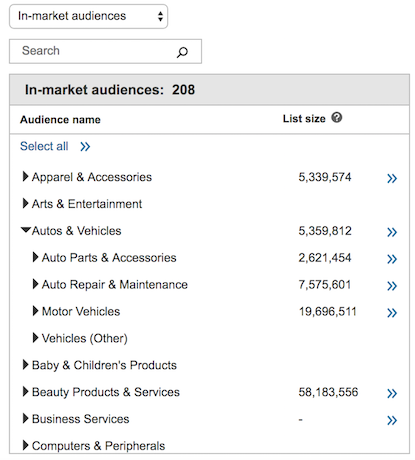In-Market Audiences: Bing’s Latest Targeting Feature

Bing Ads recently released a new intent based audience targeting for search campaigns called in-market audiences. These new in-market audiences are designed to allow advertisers to target users that Bing determines are ready to make a purchase. Bing Ads’ in-market audiences are now available for search campaigns in the U.S. market.
What are they?
Bing Ads’ in-market audiences utilize artificial intelligence (AI) to curate audience lists of users who have shown purchase intent signals in one of various categories currently available. The purchase intent signals used to generate the audience lists include searches, clicks, page views, or other interactions on Bing or Microsoft services. Once the lists are applied to search campaigns, advertisers can either target only the users on the list (target and bid) or make bid adjustments for users on the list (bid only).
There are currently 208 in-market audiences to choose from with categories ranging from in-market for car batteries to in-market for air travel. There are currently 21 broad categories such as Auto & Vehicles or Travel with sub-categories available in all. Bing Ads has increased the number of available in-market audiences since they launched, and we should expect the in-market audience categories to continue expanding. Bing Ads in-market audiences are available in all campaign types including shopping and search.

The introduction of in-market audiences demonstrates that Bing and Microsoft are now taking major steps to leverage user data from across their network to provide value for advertisers. Prior to the introduction of Bing Ads’ in-market audiences, Google was the only platform that provided AI driven audience insights using data across a large and diverse audience network.
Impact
According to Bing, in-market audience targeting had a major positive impact on conversion rate and click-through-rates, with conversion rates increasing 48% and click-through-rates increasing 28% for advertisers participating in the pilot.
The success or failure of Bing Ads in-market audiences will likely depend heavily on how much data the Bing and Microsoft network has on users in the audience you want to target. Advertisers who have had previous success with Bing users will likely experience the biggest positive impacts of the in-market audiences. The degree to which an advertiser’s customers aligns with available in-market audience categories will also play a major role in the success for each advertiser.
Conclusion
The availability of low funnel in-market audiences combined with the ease of setup make testing in-market audiences a no-brainer for most advertisers. Bing Ads’ in-market audiences represent a valuable example of successfully pairing large data and AI to provide value for advertisers. As digital advertisers, it’s time to accept that soulless AI tools are now beginning to add significant value to advertising campaigns.



